
09-01-2026 10:08
 Blasco Rafael
Blasco Rafael
Hola, en el mismo habitat que la anteriorRetamaDia

08-01-2026 21:22
 Blasco Rafael
Blasco Rafael
Hola, He recogido esta muestra de Orbilia sobre Re

07-01-2026 10:24
 Danny Newman
Danny Newman
Pezicula sp. on indet. hardwood Appalachian Highl

07-01-2026 22:22
 Danny Newman
Danny Newman
Tatraea sp. on indet. hardwood The Swag, Great Sm

07-01-2026 17:29
 Marc Detollenaere
Marc Detollenaere
Dear Forum,On a barkless Populus I found some smal

10-11-2021 17:33
 Riet van Oosten
Riet van Oosten
Add-on topic http://www.ascofrance.com/forum/7059

07-01-2026 10:05
 Danny Newman
Danny Newman
cf. Chaetospermum on XylariaCosby Campground, Grea

02-01-2026 17:43
MARICEL PATINOHi there, although I couldn't see the fruitbody, I

04-01-2026 17:45
 Stephen Martin Mifsud
Stephen Martin Mifsud
I was happy to find these orange asmocyetes which
• Habitat, macro, and particularly colour suggested O. xanthostigma.
• Orbilia series Orbilia, key D: cashew-shaped spores and clavate-capitate paraphyses.
• O. xanthostigma-leucostigma complex: Shorter spores, 8-spored asci, no glassy processes, distinct warts on the long/dorsal edge, SBs globose, hygric wood.
• O. xanthostigma: Apothecia pale to bright yellow-orange, growing +/- exposed.
Habitat: On the sawn end and sides of a stump and the trunk on the floor, decorticated parts, from bark and pores the tree looks like Fraxinus excelsior (or Quercus robur), damp at the time and appears hygric, damp area with dappled sun, no bodies of water in the immediate vicinity, mixed deciduous woodland, southern England, end of April.
Associates: Possibly another Orbilia (series Orbilia) sp. with identical macro but only orange colour (no micro yet) also on the stump, a significant number of springtails (even in storage), thick algae around base (could have developed more in vitro).
Apothecia: Many hundreds, in groups of various sizes, more numerous with some cover, gregarious to 3-caespitose, discoid, small – diameter (0.3) 0.5-0.8 (1) mm, bright yellow-orange to more yellow, one group patchy or fully pale whitish-yellowish, translucent, discoid, shallow, superficial, sessile, appressed, gelatinous appearance and texture; margin quite narrow, round to distinctly lobate, raised and uneven height in maturity; disc lighter and more translucent, with dark patches of the substrate showing through, usually slightly concave.
Although one group of apothecia described and pictured are more whitish and have not been examined microscopically, there appear to be intermediary forms, and even a gradient. This seems to suggest they are likely the same species, but with different amounts of carotenoids (possibly due to age or environmental factors).
Storage and methods: Stored in a damp box for almost a fortnight, still attached to a piece of wood, two central sections taken from a mature-looking orange-yellow apothecium from a sample of the trunk, mounted in water, some tapping to separate the cells of the hymenium.
Asci: Cylindrical to clavate, simple septa, bifurcate with H, h, L, y, and complex shapes observed, apex rounded to truncate, lower spores often more variably oriented, many free spores in water mount and one ascus observed discharging, possibly with a slit-like pore, spores appear to be somewhat interlocked in discharge due to shape.
• Living mature: ~35-46 x 3.4-4.2 (4.5) µm, pars sporifera ~20-40%, apex hemispherical, 1-2-seriate, spores highly bunched at apex when fully mature, often more horizontally oriented toward apex,
• Dead mature: ~27-40 x 3-3.5 (4) µm wide, pars sporifera ~40-60%, apex more obtuse-truncate in front view, 1-seriate, occasionally concave, sometimes with small thickening,
Spores: Reniform to cashew-shape (heteropolar), strongly-curved/semicircular, small, poles rounded-obtuse, sometimes heteropolar with the base more attenuated and acute, SB around the apex, globose with ~0.5 µm diameter, some smallish green LBs of similar size around the poles, small warts < ~0.25 µm high, often shadowy, mostly seen as a ridge along the long/dorsal edge, apparently some on the faces, not seen on the short/ventral edge,
Mature, vital spore measured in water mount, excluding warts: (2.4) 2.7-2.9 (3.1) × 1.3-1.6 µm, Q = (1.5) 1.8-2.3 (2.5), n = 11, mean = 2.9 × 1.4 µm, Q mean = 2.
Paraphyses: 2-3 septate, sometimes branching at basal septa, once observed branching at apical speta, apical cell usually longer 1.5-2x, apically inflated ~2.5-4 (5) µm wide, clavate-capitate to irregular (additional subapical inflation, asymmetric), sometimes basal/middle cell with a small knob-like protrusion.
Exudate: None observed.
VBs: Pale yellow to golden yellow (in concentration), large, medium refractive, in paraphyses, subhymenium, marginal cells, and patchy in upper medullary ex.
LBs: Carotenoid, appearing orangish at lower magnification, at high magnification a medium size yellowish one and several small to medium size red ones, in paraphyses near septa and in apex, and apparently in all cells of the excipulum. Possibly the yellowish ones are instead vacuolised VBs.
Subhymenium: Yellow, with some carotenoid LBs (in paraphysis hyphae?), at the edge indistinguishable from the medullary ex.
Medullary ex: Patchy yellow, more yellow close to subhymenium, in the centre textura globosa-prismatica; separated from ectal ex. by a broad band of horizontal hyphae, at the top thinner and textura porecta, below more like ectal ex. (wider and textura prismatica-globosa).
Ectal ex: Hyaline, appearing more rosey-orange around lower flanks, textura globosa-prismatica, more globosa at the surface, carotenoid LBs (like paraphysis), generally large cells but smaller at base, generally perpendicular to the surface and more so towards the surface.
Marginal cells: Yellow-orange, transitioning around upper flanks, more elongated and clavate, some branching at septa.
Basal attachment: Some brownish hyphae around base and lower flanks (unrelated?), branching occasionally; possibly some hyaline hyphae but difficult to see in all the algae.



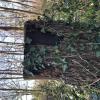
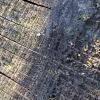
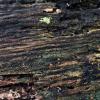
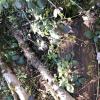
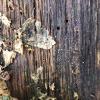
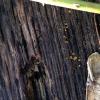
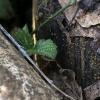
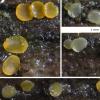
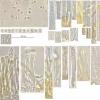
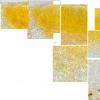
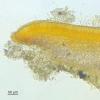
 Hymenium-0009.jpeg
Hymenium-0009.jpeg